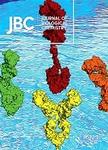版权所有:内蒙古大学图书馆 技术提供:维普资讯• 智图
内蒙古自治区呼和浩特市赛罕区大学西街235号 邮编: 010021

作者机构:Johns Hopkins Univ Sch Med Dept Neurosci Baltimore MD 21205 USA
出 版 物:《JOURNAL OF BIOLOGICAL CHEMISTRY》 (生物化学杂志)
年 卷 期:1999年第274卷第35期
页 面:24703-24713页
核心收录:
学科分类:0710[理学-生物学] 071010[理学-生物化学与分子生物学] 07[理学]
基 金:NIDA NIH HHS [DA-00266] Funding Source: Medline
主 题:促肾上腺皮质激素/代谢 天冬氨酸内肽酶类/代谢 钙/代谢 细胞系 酶激活 荧光抗体技术 基因 myc 糖基化 高尔基体/代谢 氢离子浓度 膜蛋白质类/代谢 混合功能氧化酶类 多酶复合物 前阿片黑素细胞皮质激素/代谢 前蛋白转化酶1 前蛋白转化酶2 前蛋白转化酶类 重组融合蛋白质类/遗传学 溶解度 底物特异性 枯草杆菌蛋白酶类/代谢 转染 动物 人类 小鼠
摘 要:Many peptide hormones and neuropeptides are processed by members of the subtilisin-like family of prohormone convertases (PCs), which are either soluble or integral membrane proteins. PC1 and PC2 are soluble PCs that are primarily localized to large dense core vesicles in neurons and endocrine cells. We examined whether PC1 and PC2 were active when expressed as membrane-tethered proteins, and how tethering to membranes alters the biosynthesis, enzymatic activity, and intracellular routing of these PCs. PC1 and PC2 chimeras were constructed using the transmembrane domain and cytoplasmic domain of the amidating enzyme, peptidylglycine cu-amidating monooxygenase (PAM). The membrane-tethered PCs were rerouted from large dense core vesicles to the Golgi region. In addition, the chimeras were transiently expressed at the cell surface and rapidly internalized to the Golgi region in a fashion similar to PAM. Membrane-tethered PC1 and PC2 exhibited changes in pro domain maturation rates, N-glycosylation, and in the pH and calcium optima required for maximal enzymatic activity against a fluorogenic substrate. In addition, the PC chimeras efficiently cleaved endogenous pro-opiomelanocortin to the correct bioactive peptides. The PAM transmembrane domain/cytoplasmic domain also prevented stimulated secretion of pro-opiomelanocortin products in AtT-20 cells.